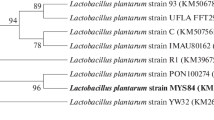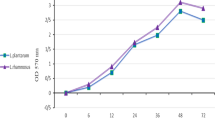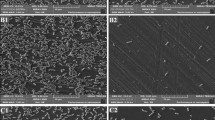Abstract
Beneficial effects of Lactobacilli have been reported, and lactic bacteria are employed for conservation of foods. Therefore, the effects of a Lactobacillus fermentum strain were analyzed regarding inhibitory effects on staphylococci, Candida albicans and enterotoxigenic enterobacteria by transmission electron microscopy (TEM). TEM of bacterial biofilms was performed using cocultures of bacteriocin-producing L. fermentum 97 with different enterotoxigenic strains: Staphylococcus epidermidis expressing the ica gene responsible for biofilm formation, Staphylococcus aureus producing enterotoxin type A, Citrobacter freundii, Enterobacter cloaceae, Klebsiella oxytoca, Proteus mirabilis producing thermolabile and thermostable enterotoxins determined by elt or est genes, and Candida albicans. L. fermentum 97 changed morphological features and suppressed biofilm formation of staphylococci, enterotoxigenic enterobacteria and Candida albicans; a marked transition to resting states, a degradation of the cell walls and cytoplasm, and a disruption of mature bacterial biofilms were observed, the latter indicating efficiency even in the phase of higher cell density.
Similar content being viewed by others
Avoid common mistakes on your manuscript.
Introduction
Bacterial biofilms are universal, occurring in aquatic and industrial water systems as well as a large number of environments and medical devices relevant to public health (Donlan and Costerton 2002). High-resolution microscopy techniques such as transmission electron microscopy (TEM) and confocal laser scanning microscopy (CLSM) demonstrated that biofilms represent structures containing homogeneous deposits of cells and accumulated slime with complex communities of surface-associated cells enclosed in a polymer matrix containing water channels and were described for gram-positive and gram-negative microorganisms (O’Gara 2007; Rybalchenko et al. 2010; Sadowska et al. 2010).
Bacteria grow in matrix-enclosed biofilms adherent to surfaces in all nutrient sufficient aquatic ecosystems, and therefore these sessile bacterial cells deeply differ from single cells in suspension counterparts. Numerous studies demonstrated that biofilm-associated microorganisms are linked to several human diseases, such as inflammatory bowel disease, endocarditis and cystic fibrosis, and colonize a wide variety of medical devices (O’Gara 2007; Swidsinski et al. 2005). Though epidemiologic evidence points to biofilms as a source of several infectious diseases, the exact mechanisms by which biofilm-associated microorganisms elicit disease are only beginning to emerge (Holm and Vikström 2014).
The ultrastructure of single bacteria in suspension is well known, as the peculiarity of organization indicating cell specialization, cooperation in communities with antagonistic microorganisms in the special organization of monoculture and mixed bacteria of different taxonomic groups has been demonstrated (Rybalchenko 2006). Whereas in contrast Lactobacillus were not sufficiently analyzed in this context, nevertheless some studies showed that lactobacilli are able to inhibit growth of gram-positive and gram-negative bacteria and yeasts (Kouakou et al. 2010; Rivas-Santiago et al. 2009). The main antagonistic qualities of lactobacilli are due to the antimicrobial peptides (AMP) or bacteriocin-like inhibitory substance (De Vos et al. 1995; Garver and Muriana 1993; Rybalchenko et al. 2014). Furthermore, AMP bactericidal nonspecific metabolites including lactic acid, hydrogen peroxide and lysozyme have been identified (Cotter et al. 2005; Diep and Nes 2002; Lebeer et al. 2008; Turovskiy et al. 2009). The synthesis and impacts of these inhibitory factors exemplify quorum-sensing (QS) processes (Miller and Bassler 2001; Holm and Vikström 2014).
Moreover, bacterial biofilm formation and expression of pathogenic factors are closely associated with the global regulatory system of prokaryotic cells. Recently it was found that QS-regulator factors of Staphylococcus biofilm formation include global regulation of the polysaccharide part of biofilms: δB—the activator of icaR-gene (Knobloch et al. 2004) and SarA (Tormo et al. 2005). As one regulation factor involved in the multicellular aggregation step of S. aureus biofilm formation, rbf was identified (Lim et al. 2004).
The purpose of this investigation was the transmission electron microscopic study of the structural organization and inhibition of bacterial biofilm formation of different enterotoxigenic bacteria under the influence of Lactobacillus antimicrobial compounds.
Materials and methods
Bacterial strains and growth conditions
In our work, following strains were used: Lactobacillus fermentum 97, Salmonella typhimurium 415, Escherichia coli M17, Enterococcus faecium SF68, Staphylococcus aureus ATCC 25923, Pseudomonas aeruginosa ATCC 27853, Klebsiella pneumoniae ATCC 13883, Proteus mirabilis ATCC 29906, Citrobacter freundii ATCC 8090, Candida albicans 624 and Staphylococcus epidermidis 193. Moreover, different species of clinical enterotoxigenic bacterial target strains were used: Staphylococcus aureus, producing enterotoxin type A; Citrobacter freundii, Enterobacter cloaceae, Klebsiella oxytoca, Proteus mirabilis, producing thermolabile or thermostabile enterotoxins, determined by elt or est genes, and clinical strains of Candida albicans. The strains were received from the culture museum of Gamaleya Federal Center of Epidemiology and Microbiology (Moscow). All cultures were plated on solid media: For cultivation of lactobacilli, Lactobacillus MRS Broth liquid media (HiMedia, Laboratories Pvt. Limited, India) was used, and Brain Heart Infusion Broth (HiMedia Laboratories Pvt. Limited, India) was used for all other indicator bacterial cultures. Unless stated otherwise, routine cultivation was performed overnight in a humid atmosphere at 37 °C and overnight (18–20 h) under standard incubation conditions.
Deferred antagonistic test on solid media
Deferred antagonistic test on solid media was carried out according to Tagg and Bannister (Tagg and Bannister 1979). Lactobacillus fermentum 97 was grown on Brain Heart Infusion Agar (HiMedia Laboratories Pvt. Limited, India) overnight as 1-cm-wide streak culture. Following the removal of visible growth, the plate was surface-sterilized by exposure to chloroform vapors and then air-dried for at least 30 min. Each studied bacterial culture indicator was applied at right angles to the streak of cultures by using a cotton-tipped swab. Plates were incubated and examined after 20 and 44 h of incubation for any zones of growth inhibition of the indicator bacteria.
Antagonistic activity assay
In order to determine effects of antagonistic activity including bacteriocin production, Lactobacillus was grown on the MRS agarized medium. Colonies have been grown during 2 days at 37 °C. Subsequently, a test strain (1–2 × 107 cells at the exponential growth stage) was plated on top in 2.5 ml of soft meat-peptone agar prepared in the HiMedia (India).
Transmission electron microscopy (TEM)
Preparations for carrying out TEM analysis of ultrathin sections consisted in conservation of initial frame and the regional locating of microbial cells in an investigated biofilm. Areas of bacterial growth were cut out with agar and preliminary fixed in 2.5 % solution glutaraldehyde in Hanks buffer (pH 7.2) at 4 °C. It should be noted that the fixing solution was placed under agar plate. This method of fixation was used to preserve the integrity of the surface structures of microbial communities. After 24 h, 0.5 % aqueous agarose solution (30 °C) was placed on the surface to maintain biofilm structure. Secured agarose’s biofilms were washed with distilled water and then fixed in 1.0 % OsO4 aqueous solution for one day at 4 °C.
For dehydration, samples were entirely incubated in solutions of increasing alcohols concentration in a standard procedure and embedded in resin. For clear location and orientation of sample analysis, a Pyramitome LKB-11800 was used (LKB, Sweden), which allowed correct focusing and an estimation of region location for further analysis. From regions of bacterial growth, ultrathin sections were obtained. Subsequently, preparations were analyzed employing a transmission electron microscope JEM-100C (JEOL, Japan).
Chemicals
All chemicals, unless otherwise noted, were purchased from Sigma-Aldrich.
Statistical analysis
Data are expressed as mean ± standard error of the mean (SEM), and n indicates the number of experiments.
Results
Effects of L. fermentum 97 on biofilms generated by pathogens were studied morphophysiologically. Initially, the potentially inhibitory activity of L. fermentum 97 on growth of different pathogenic gram-positive and gram-negative bacteria was detected by the deferred antagonistic test, measuring the diameter of growth inhibition zones (Table 1). The test revealed growth inhibition of all microorganisms under investigation during 24 h, including E. coli M17, E. faecium SF68, S. typhimurium 415, P. aeruginosa ATCC 27853, K. pneumoniae ATCC 13883, P. mirabilis ATCC 29906, C. freundii ATCC 8090, S. epidermidis 193, S. aureus ATCC 25923 and C. albicans 624.
Subsequently, the ultrastructural organization of populations and individual cells of sensitive cultures was tested by TEM. Employing this technique, changes of microbial cells caused by Lactobacillus antimicrobial compounds were visualized. Ultrathin changes in microbial cells, destruction of the cell wall and cytoplasm became apparent for all microorganisms under investigation, including E. coli M17 (Fig. 1a, b) and S. aureus ATCC 25923 (Fig. 2a, b, c), representing the gram-negative and gram-positive groups, respectively. At the population level, cell-to-cell interactions in the mixed populations changed the proportion of different morphotypes of cells and increased the relative number of lysed, involuted, and resting forms. The intensity of ultrastructural alterations in the cells correlated with the size of zones of bacterial inhibition (Table 1): If the diameter of inhibition zones of growth was wider, more cells have been destroyed, and cells from growth inhibition zones had multiple destructive changes in cell walls and cytoplasm.
Ultrathin sections of E. coli M17 biofilms; a control, surface structure complex of biofilm—polysaccharide amorphous layer (PAL); b after the antagonistic effect of L. fermentum 97: ribosomal protein complex (RPC), cell wall (CW), polar cytoplasmic inclusions (PCI), delamination of cytoplasm (DCy); scale bar is 1 µm
Ultrathin sections of S. aureus ATCC 25923 biofilms. a Control, surface structure complex of biofilm (SSC); b, c after the antagonistic effect of L. fermentum 97; dividing cells (DC), cell wall (CW), delamination of cytoplasm (DCy) and delamination of cell wall (DCW), pore formation in cell membrane (PF), lysed cell (LC); damaged bacteria showing destroyed cell walls (b), and thickened cell walls and disturbed cell division (DCD)—(c); scale bar is 1 µm
The ultrastructural changes in lactobacilli cells indicated possession of specific protecting mechanisms, associated with cell transformation into resting forms, and production of submembrane vesicles, globules and additional protecting layers on the cell surface (Fig. 3).
The presented data show a specific character of cell-to-cell interactions between lactobacilli and the different opportunistic microorganisms at the cellular and population level. This fact suggests the existence of a special form of social behavior of microorganisms inside mixed microbial communities on the model of antagonistic interactions. TEM confirmed the various morphophysiological changes of target cells of Enterobacteriaceae and Staphylococcus during interaction with antimicrobial compounds of L. fermentum 97.
Discussion
Microbial colonization of the mucous membranes of the gastrointestinal and urogenital tracts depends on adhesion of prokaryotic cells and formation of colonies forming biofilms (Macfarlane 2008; Tenke et al. 2012).
Normal microflora prevents the spread of opportunistic pathogens bacteria from these biotopes and their translocation into the systemic circulation (Madden et al. 2005; Manzoni 2007). Previously, we have shown that lactobacilli can exhibit antagonistic properties and are able to destroy cells of opportunistic pathogenic bacteria (Rybalchenko 2006). Lactobacillus also can block the translocation of opportunistic pathogenic bacteria and penetration of their toxins from the mucosa into systemic circulation, perhaps by inhibition of bacterial transcytosis (Tuma and Hubbard 2003). However, currently there is no information regarding microbe-to-microbe interactions between Lactobacillus and other opportunistic pathogen bacteria during formation of biofilms. Therefore, it is difficult to acquire a detailed comprehension of the mechanisms involved in the process of inhibition of biofilm formation by antimicrobial compounds.
Currently, nature, physicochemical properties and mechanism of action of bacteriocin-like inhibitory substance (BLIS) are the subject of intensive research (Belfiore et al. 2007; Pinto et al. 2013; Zaeim et al. 2014). Our study focusing on TEM indicates that antimicrobial compounds of Lactobacillus, possibly mediated by BLIS, are sufficient to inhibit bacteria of all different taxonomic groups under investigation.
The changes of microbial biofilms ultrastructure dependent on Lactobacillus antimicrobial compounds as demonstrated by TEM may allow us to understand these mechanisms of destruction of microbial communities (Rybalchenko et al. 2010, 2014). These investigations proved the fact that biofilms of bacteria as E. coli and S. aureus have complex surface structures. It can be supposed that the complex biofilm surface structure is one of the biological mechanisms for resistance to various stress factors. Further studies exhibited that microorganisms that are growing inside a biofilm are highly resistant to antimicrobial agents by one or more mechanisms.
Intestinal microbiota of rats, guinea pigs and mice has been shown to consist of biofilms of single bacterial species or mixed microbial communities of several bacterial species interacting cooperatively (Nielsen et al. 2003).
Bacterial cells within such biofilms can be physiologically heterogeneous because of the diversity of the microenvironment occurring within the biofilm structure. Cells on the surface of the structure are able to get access to nutrients, actively metabolize and begin to divide. Most part of the inside cells in biofilms possibly are in a state of rest (Rybalchenko et al. 2014). This concept of physiological heterogeneity within a biofilm, unlike the relative physiological synchrony of bacteria suspended as individual cells in broth culture, explains that vastly different susceptibilities to antibiotics are a result of heterogeneity of cells within biofilms.
In conclusion, this study revealed that probiotic strain L. fermentum 97 reduces growth and development of biofilms of different gram-negative and gram-positive opportunistic bacteria. The activity of L. fermentum 97 antimicrobial compounds against Staphylococcus, Enterobacteriaceae, including E. coli, Klebsiella, Enterobacter, Citrobacter, Proteus and clinical strains of Candida albicans are probably due to the destruction of the cell wall and cytoplasm by formation of transient pores in the cytoplasmic membrane. A clear understanding of this phenomenon is important for design and development of new antimicrobial medicine and probiotics.
References
Belfiore C, Castellano P, Vignolo G (2007) Reduction of Escherichia coli population following treatment with bacteriocins from lactic acid bacteria and chelators. J Food Microbiol 24:223–229
Cotter PJ, Hill S, Ross RP (2005) Bacteriocins: developing innate immunity for food. Nat Rev Microbiol 3:777–788
De Vos WM, Kuipers JR, Van der Meer JR, Slesen RJ (1995) Maturation pathway of nisin and other lantibiotics: post-translationally modified antimicrobial peptides exported by gram-positive bacteria. Mol Microbiol 17:427–437
Diep DB, Nes IF (2002) Ribosomally synthesized antibacterial peptides in gram-positive bacteria. Curr Drug Targets 3:107–122
Donlan RM, Costerton JW (2002) Biofilms: survival mechanisms of clinically relevant microorganisms. Clin Microbiol Rev 15:167–193
Garver KI, Muriana PM (1993) Detection, identification and characterization of bacteriocin-producing lactic acid bacteria from retail food products. Int J Food Microbiol 19:241–258
Holm A, Vikström E (2014) Quorum sensing communication between bacteria and human cells: signals, targets, and functions. Front Plant Sci 5:309. doi:10.3389/fpls.2014.00309
Knobloch JK, Jäger S, Horstkotte MA, Rohde H, Mack D (2004) Rsb U-dependent regulation of Staphylococcus epidermidis biofilm formation is mediated via the alternative sigma factor sigma B by repression of the negative regulator gene ica R. Infect Immun 72:3838–3848
Kouakou P, Dortu C, Dubois-Dauphin R, Vandenbol M, Thonart P (2010) Plasmid-associated bacteriocin production by Lactobacillus LMG21688 suppresses Listeria monocytogenes growth rebound in a food system. FEMS Microbiol Lett 306:37–44
Lebeer S, Vanderleydes G, De Keersmaecker SCJ (2008) Genes and molecules of Lactobacillus supporting probiotic action. Microbiol Mol Biol Rev 72:728–764
Lim Y, Jana M, Luong TT, Lee CY (2004) Control of glucose- and NaCl-induced biofilm formation by rbf in Staphylococcus aureus. J Bacteriol 186:722–729
Macfarlane S (2008) Microbial biofilm communities in the gastrointestinal tract. J Clin Gastroenterol 42:S142–S143
Madden JA, Plummer SF, Tang J, Garaiova I et al (2005) Effect of probiotics on preventing disruption of the intestinal microflora following antibiotic therapy: a double-blind, placebo-controlled pilot study. Int Immunopharmacol 5:1091–1097
Manzoni P (2007) Use of Lactobacillus casei subspecies Rhamnosus GG and gastrointestinal colonization by Candida species in preterm neonates. J Pediatr Gastroenterol Nutr 45:S190–S194
Miller MB, Bassler BL (2001) Quorum sensing in bacteria. Ann Rev Microbiol 55:165–199
Nielsen DS, Moller PL, Rosenfeld V, Paerregaard A et al (2003) Case study of the distribution of mucosa-associated Bifidobacterium species, Lactobacillus species, and other lactic acid bacteria in the human colon. Appl Environ Microbiol 69:7545–7548
O’Gara JP (2007) Ica and beyond: biofilm mechanism and regulation in Staphylococcus epidermidis and Staphylococcus aureus. FEMS Microbiol Lett 270:179–188
Pinto TS, de Oliveira CP, da Costa AC, Lima CO et al (2013) Evidence for production of a bacteriocin-like substance by Staphylococcus pseudintermedius, inhibitory to Staphylococcus aureus from foods. Nat Prod Res 27:1098–1101
Rivas-Santiago B, Serrano CJ, Ensico-Moreno JA (2009) Susceptibility to infectious diseases based on antimicrobial peptide production. Infect Immun 77:4690–4695
Rybalchenko OV (2006) The electron microscopic study of cell-to-cell interactions between antagonistic microorganisms. Mikrobiologiia 75:550–555
Rybalchenko OV, Bondarenko VM, Orlova OG, Larionov IV, Fialkina SV (2010) Disorganization of biofilms of clinical strains of staphylococci by metabolites of lactobacilli. Zh Mikrobiol Epidemiol Immunobiol 6:66–70
Rybalchenko OV, Bondarenko VM, Orlova OG (2014) Ultrastructure of microbial biofilms during interspecies and intraspecies interactions of bacteria in communities. Zh Mikrobiol Epidemiol Immunobiol 2:97–101
Sadowska B, Walencka E, Wieckowska-Szakiel M, Różalska B (2010) Bacteria competing with the adhesion and biofilm formation by Staphylococcus aureus. Folia Microbiol 55:497–501
Swidsinski A, Weber J, Loening-Baucke V, Hale LP, Lochs H (2005) Spatial organization and composition of the mucosal flora in patients with inflammatory bowel disease. J Clin Microbiol 43:3380–3389
Tagg JR, Bannister LV (1979) ‘Fingerprinting’ ß-haemolytic streptococci by their production of and sensitivity to bacteriocine-like inhibitors. J Med Microbiol 12:397–411
Tenke P, Köves B, Nagy K, Hultgren SJ et al (2012) Update on biofilm infections in the urinary tract. World J Urol 30:51–57
Tormo MA, Martí M, Valle J, Manna AC et al (2005) SarA is an essential positive regulator of Staphylococcus epidermidis biofilm development. J Bacteriol 187:2348–2356
Tuma P, Hubbard AL (2003) Transcytosis: crossing cellular barriers. Physiol Rev 83:871–932
Turovskiy Y, Ludescher RD, Aroutcheva AA, Faro S, Chikindas ML (2009) Lactocin 160, a bacteriocin produced by vaginal Lactobacillus rhamnosus, targets cytoplasmic membranes of the vaginal pathogen, Gardnerella vaginalis. Probiotics Antimicrob Proteins 1:67–74
Zaeim D, Soleimanian-Zad S, Sheikh-Zeinoddin M (2014) Identification and partial characterization of a bacteriocin-like inhibitory substance (BLIS) from Lb. bulgaricus K41 isolated from indigenous yogurts. J Food Sci 79:M67–M73
Acknowledgments
This research was sponsored by St. Petersburg State University Grant 0.37.123.2011, by Russian Foundation for Basic Research Grant 13-04-01107, and by the Center of International Cooperation of Freie Universität Berlin.
Author information
Authors and Affiliations
Corresponding author
Additional information
Communicated by Erko Stackebrandt.
Rights and permissions
About this article
Cite this article
Rybalchenko, O.V., Bondarenko, V.M., Orlova, O.G. et al. Inhibitory effects of Lactobacillus fermentum on microbial growth and biofilm formation. Arch Microbiol 197, 1027–1032 (2015). https://doi.org/10.1007/s00203-015-1140-1
Received:
Revised:
Accepted:
Published:
Issue Date:
DOI: https://doi.org/10.1007/s00203-015-1140-1







